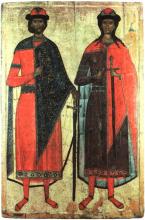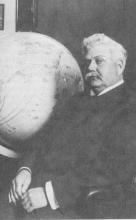The offering of Russian at the University of Washington is intricately tied to the history of Samuel Hill (1857-1931, n.d. photo courtesy Oregon Historical Society) and the Pacific Northwest. A well-known transportation and utilities magnate in Seattle, Hill travelled from Asia to Europe in 1901 using parts of the then incomplete Trans-Siberian Railway, and also carried out a mission for the U.S. Government to evaluate Russian railways during World War I. In addition to funding provided to the UW to teach Russian, his legacy to Washington State can still be seen today, and includes the Peace Arch at Blaine and Maryhill Museum in Goldendale, which has in its collection an interesting group of 19th-century Russian icons.
Russian language instruction was first offered at the University of Washington in the 1915-16 academic year by a German professor, Hans Jacob Hoff. The following year, a native speaker of Russian, Elvine Simeon, was hired with financial support from Samuel Hill to teach Russian language, literature, reading and grammar in the Department of Oriental History, Literature, and Languages. Her courses were listed in the University Catalog for two years, after which there appears to have been a 15-year hiatus in the teaching of Russian at the UW.
A Fresh Start
In 1933, Russian was reintroduced by Ivar Spector, at that time an instructor in Oriental Studies, who expanded the offerings in Russian literature, history, and culture through the 1930s and early ’40s. George Taylor, who joined the Department of Oriental Studies in 1939, increased both its size and stature during his tenure as its head. In 1943, Noah Gershevsky joined the Far Eastern Department, and was in charge of Russian language teaching until 1963. Vadim Pahn and Elias Novikov were added as Russian language instructors in 1946 and 1947, respectively, and in 1949 Victor Ehrlich joined them as an assistant professor of Slavic Languages & Literatures. In 1953, the appointment of Lew Micklesen, who took over most of the courses in Slavic linguistics, made it possible for the offerings in Russian literature to be expanded.

In 1954, Slavic graduate studies were introduced, and the first doctorate was awarded in 1960. Polish was introduced in 1954, Czech in 1962, and both languages have been regularly taught since then. In 1964 a well-integrated four-year Russian language program was established.
Travels In The Far East
From 1933 to 1968, Russian and other Slavic studies were administratively a branch of Oriental Studies at the University of Washington. First in the Department of Oriental Studies (1933-42), then in the Far Eastern Department (1942-49), and finally in the Department of Far Eastern and Slavic Languages & Literatures (1949-68). In 1968 we achieved our autonomy as the Department of Slavic Languages & Literatures, but our ties with our original mother institution (as of 1968, called the School of International Studies, and now known as the Jackson School of International Studies) are still profound and mutually beneficial.
Finally, A Department
The Department of Slavic Languages & Literatures in its present form was created in 1968, with Reid (Lew) Micklesen as its first chair, followed in 1970 by Jack Haney and in 1977 by Davor Kapetanic. Karl Kramer assumed the chair in 1988 and held the position until 1998, with James Augerot replacing him as Acting Chair from December 1993 to September 1996. Jack Haney returned to the helm from 1998 to 2001, and was succeeded in November of that year by Galya Diment, who served as Chair through June 2012. In July 2012 Katarzyna Dziwirek became Chair, and passed the torch to Gordana Crnković in the summer of 2022.
Bulgarian was first taught in 1965 and Romanian in 1970, and both these languages were taught regularly from 1970 into the 2000s. An intensive summer language program, introduced in 1952, now covers first and second years of Russian.
The Slavic Department is closely associated with the Russian, East European and Central Asian Studies (REECAS) Program, an interdisciplinary area studies program and National Resource Center in the Jackson School of International Studies. REECAS students study the languages of the Slavic and East European region in the department, which also provides the literature and culture component of their interdisciplinary degree programs. Slavic Department courses have with increasing frequency been cross-listed with other departments and programs, including Comparative Literature, Art History, Film Studies, Jewish Studies and Comparative History of Ideas.
Learn about our revised Mission Statement, a reflection of our continuous effort to enrich our curriculum and strengthen our ties with the Ellison Center (REECAS) and other relevant departments and programs. Or read our By-Laws, which describe departmental committees and faculty governance procedures.
